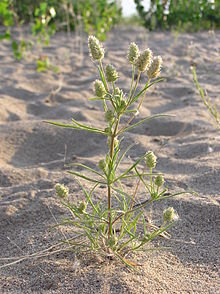Sand plantain
| Sand plantain | ||||||||||||
|---|---|---|---|---|---|---|---|---|---|---|---|---|

Sand plantain ( Plantago arenaria ) |
||||||||||||
| Systematics | ||||||||||||
|
||||||||||||
| Scientific name | ||||||||||||
| Plantago arenaria | ||||||||||||
| Waldst . & Kit . |
The sand plantain ( Plantago arenaria , Syn. : Psyllium arenarium ... (Waldst & Kit) Mirb ) is a plant from the genus of plantains ( Plantago ) in the family of Plantain Family (Plantaginaceae).
description
The sand plantain is a therophyte up to 50 cm high . The plant is branched to upright and bushy. The stem is loosely bristly or hairy in a scattered manner. The leaves are linear-lanceolate, opposite, flat, thin, 3-nerved, 6–8 cm long, 3–4 mm wide, at the base sheath-like, entire to bluntly serrate. A basal leaf rosette is missing.
The flowers are in many- and densely-flowered egg-shaped, long-stalked spikes in the axils of the upper leaves. The corolla is 4 mm long, glabrous, cross-wrinkled, the corolla tube is brownish white. The calyx is stiff-haired. The fruit capsule contains 2 dark brown, shiny seeds , the umbilical side of which is thickened at the edge.
Flowering time is from June to September.
The number of chromosomes is 2n = 12.
ecology
The plant is wind flowering . The slimy seeds spread out as sticky.
Distribution and locations
The sand plantain is particularly widespread in the southern and eastern parts of Europe and reaches the western limit of its distribution in Central Europe. It is also found in North and East Africa, Asia Minor and western Siberia. In Germany it is found mainly in the eastern part, on the lower Elbe and (in the sandy areas) on the Upper and Lower Rhine.
It grows in loose stands on sunny to light-rich, moderately dry, mostly calcareous, basic, at most moderately nutrient-rich, loose sandy soils, also on track gravel. Often it is also abducted as a neophyte to ruderal sites. It is characteristic of the Plantaginetum arenariae from the Salsolion association.
Systematics
One can distinguish the following subspecies:
- Plantago arenaria subsp. orientalis (Soó) Greuter & Burdet : It occurs in Ukraine.
- Plantago arenaria Waldst. & Kit. subsp. arenaria
literature
- Henning Haeupler , Thomas Muer: picture atlas of the fern and flowering plants of Germany (= the fern and flowering plants of Germany. Volume 2). 2nd, corrected and enlarged edition. Published by the Federal Agency for Nature Conservation. Ulmer, Stuttgart 2007, ISBN 978-3-8001-4990-2 .
- Erich Oberdorfer : Plant-sociological excursion flora for Germany and neighboring areas . Ulmer-Verlag, ISBN 978-3-8001-3131-0
- Oskar Sebald, Siegmund Seybold, Georg Philippi: The fern and flowering plants of Baden-Württemberg . Ulmer Verlag, Volume 5
- Ruprecht Düll , Herfried Kutzelnigg : Pocket dictionary of plants in Germany and neighboring countries. The most common Central European species in portrait. 7th, corrected and enlarged edition. Quelle & Meyer, Wiebelsheim 2011, ISBN 978-3-494-01424-1 .
- Schmeil-Fitschen: The flora of Germany interactive , ISBN 3-494-01368-3
Individual evidence
- ↑ a b Erich Oberdorfer : Plant-sociological excursion flora for Germany and neighboring areas . With the collaboration of Angelika Schwabe and Theo Müller. 8th, heavily revised and expanded edition. Eugen Ulmer, Stuttgart (Hohenheim) 2001, ISBN 3-8001-3131-5 , pp. 874 .
- ↑ a b Karol Marhold, 2011: Plantaginaceae : Datasheet Plantago arenaria In: Euro + Med Plantbase - the information resource for Euro-Mediterranean plant diversity.
Web links
- Plantago arenaria Waldst. & Kit., Sand plantain. In: FloraWeb.de.
- Sand plantain . In: BiolFlor, the database of biological-ecological characteristics of the flora of Germany.
- Profile and distribution map for Bavaria . In: Botanical Information Hub of Bavaria .
- Plantago arenaria Waldst. & Kit. In: Info Flora , the national data and information center for Swiss flora . Retrieved March 28, 2016.
- Thomas Meyer: Plantain data sheet with identification key and photos at Flora-de: Flora von Deutschland (old name of the website: Flowers in Swabia )
- http://www.phytodoc.de/heilpflanze/flohsamen-indischer-flohsamen/aussehen-herkunft/
- http://luirig.altervista.org/cpm/albums/flora-batava3/flo-bat16-1372-plantago-arenaria.jpg
